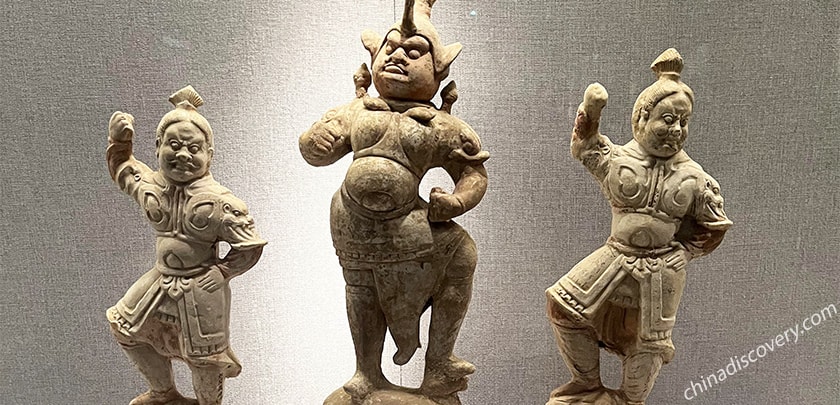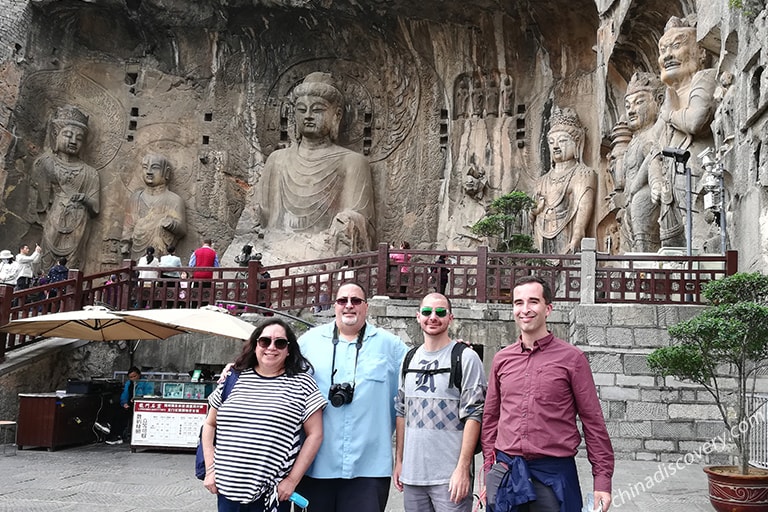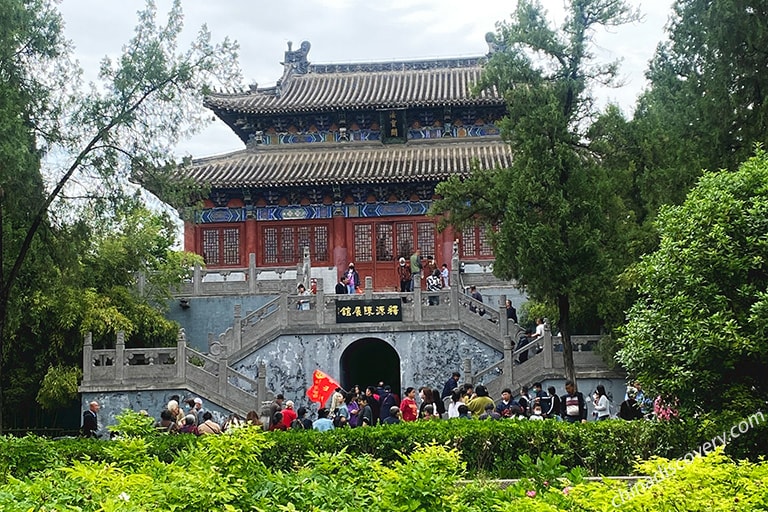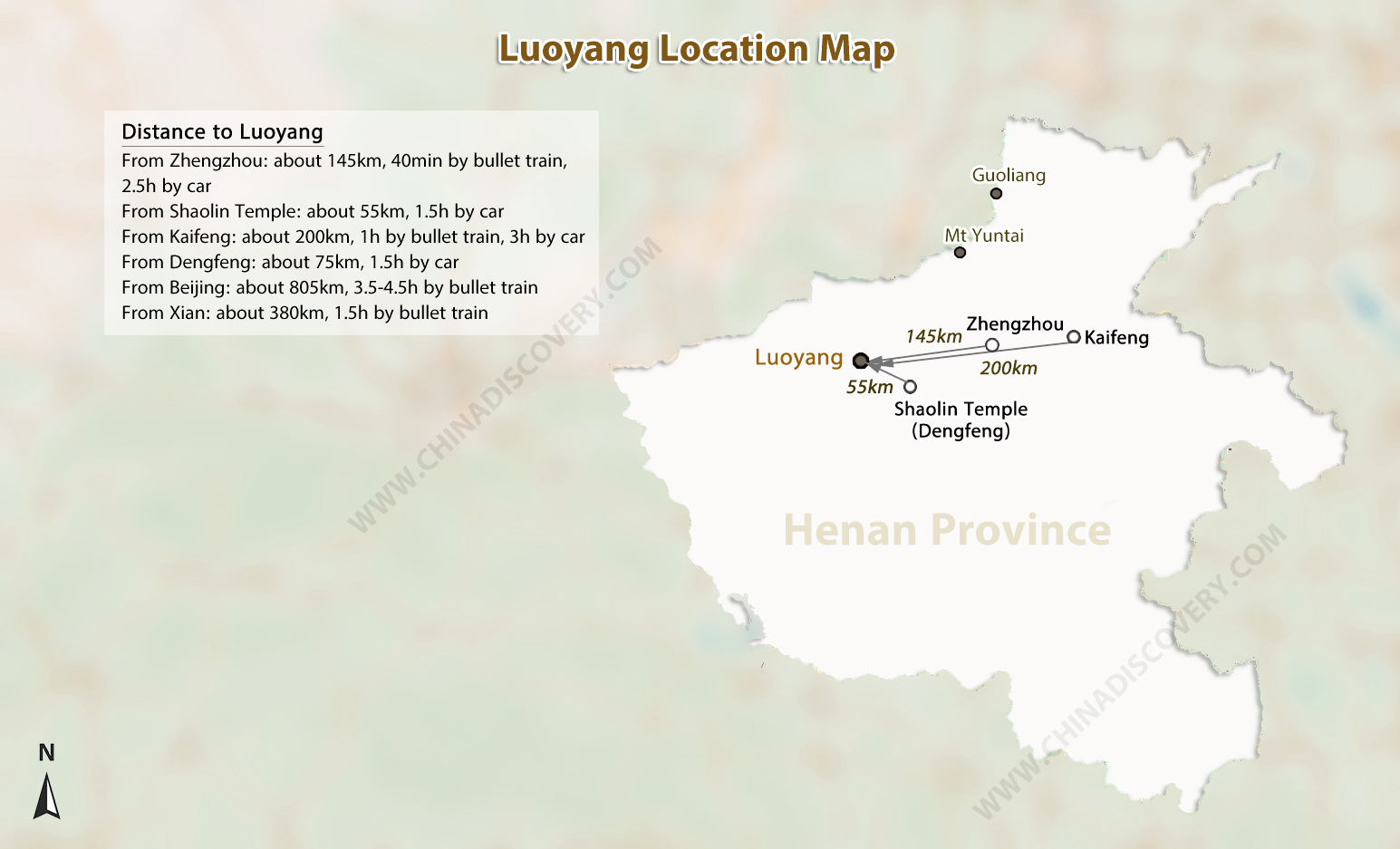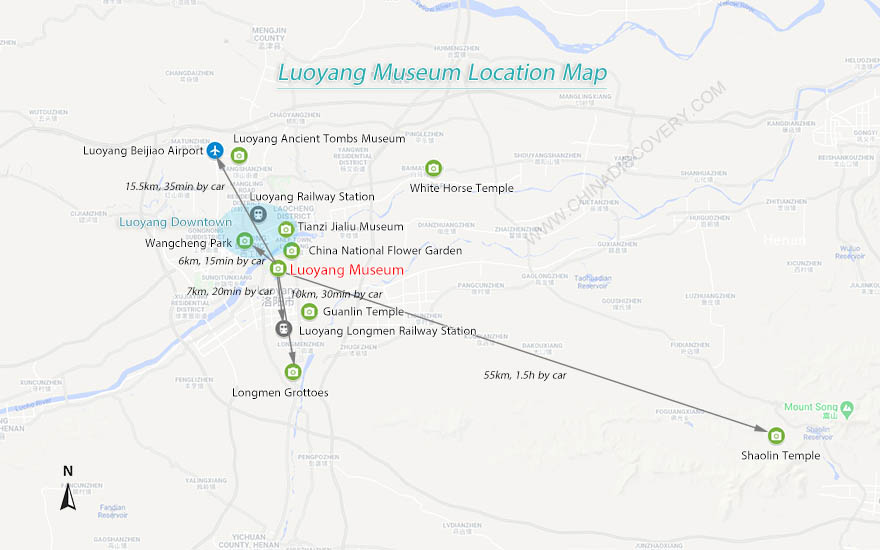Brief Introduction of Luoyang Museum
Luoyang Museum was established in 1958, covering an area of 200,000 m². It is one of the first batch of national first-class museums in China as well as the only comprehensive history museum in Luoyang. More than 400,000 pieces of cultural relics are collected here, and more than 11000 pieces of them are on display. The main building of Luoyang Museum has two floors and looks like a “ding 鼎”, an ancient cooking vessel and a symbol of dynasty in Chinese culture, indicating the important role Luoyang has played as the capital for 13 dynasties in the history of China.
What to See in Luoyang Museum
Luoyang Museum exhibition hall includes a basic exhibition of Heluo Civilization and 6 specific halls that present the history and culture of Luoyang from all aspects through the treasured 15000 relics such as jade, bronze, pottery, stone sculpture, calligraphy and painting.
There are five treasures of Luoyang Museum you can not miss, which are Bronze Tripod Jue with the Pattern of Nipples, Stone Bixie, Tri-colored Black Glazed Pottery Horse, White Jade Cup, and Jinsi Nanmu Pagoda.
Heluo Civilization 河洛文明展 - First Floor
The large-scale basic exhibition of "Heluo Civilization" is the most representative exhibition held in Luoyang Museum since its establishment. The exhibition area is more than 5000 square meters. The collection covers stone tools, jade, pottery, bronze, iron, porcelain, bone horn, tooth ware and many other categories. Chronically, it can be divided into five parts: prehistoric period, Xia Shang Zhou period (2070 BC - 256 BC), Han and Wei dynasties (202 BC - AD 535), Sui and Tang dynasties (AD 581 - 907), Five Dynasties and Northern Song Dynasty (AD 907 - 1127). Based on the representative cultural relics unearthed in Luoyang, the exhibition connects the major historical events, important historical relics, scientific and technological inventions in each historical period of Luoyang, fully presenting the glorious history of Luoyang as the ancient capital of thirteen dynasties, highlighting the special historical status of "Heluo civilization" as the symbol of Chinese civilization.
Representative Relics
Palaeoloxodon Fossil 古菱齿象化石: 30,000-50,000 years ago, about 2.7m in height, 5.7m in length. It is at the entrance of Heluo Civilization. It is the most complete palaeoloxodon fossil in western Henan Province and proves that Luoyang used to be the place where elephants breed.
Zishenfuji Bronze Tripod子申父己铜鼎: Shang Dynasty (1600 BC - 1046 BC), Zishenfuji Bronze Tripod is exquisitely decorated and the bird shaped flat feet are quite special. It is one of the typical utensils in the late Shang Dynasty, which shows us the superb bronze casting level at that time.
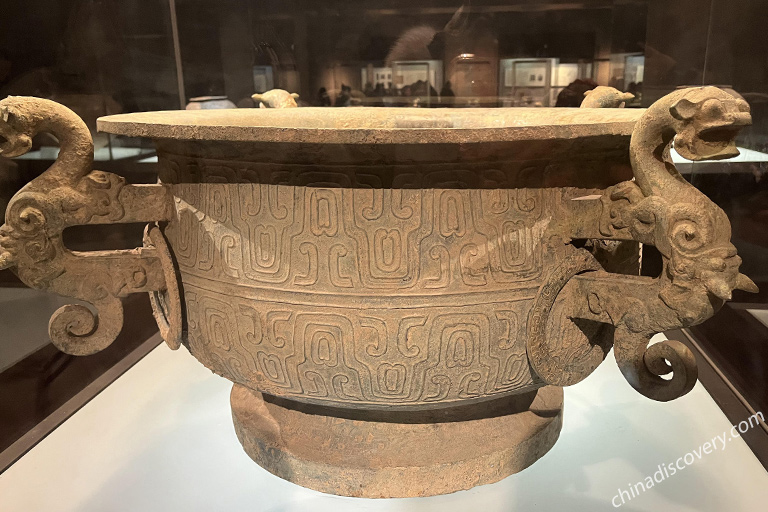 Broze Yu (770B.C.-476 B.C.)
Broze Yu (770B.C.-476 B.C.)
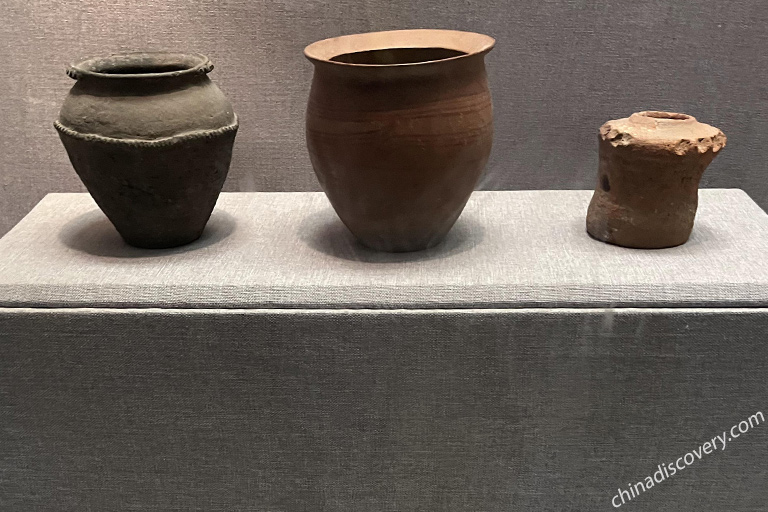 Potteries (7,000~5,000 Years Ago)
Potteries (7,000~5,000 Years Ago)
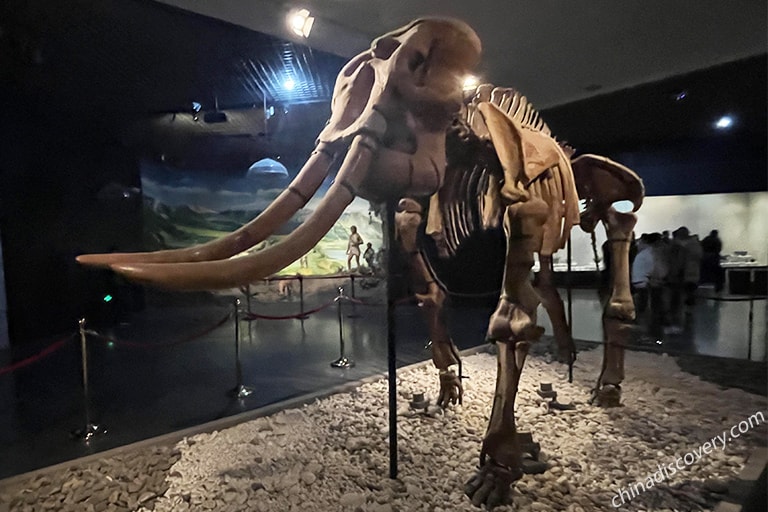 Palaeoloxodon Fossil
Palaeoloxodon Fossil
The Ancient Treasures of Luoyang 珍宝馆 - Second Floor
Thirteen dynasties successively established their capitals in Luoyang for more than 1500 years, leaving numerous cultural relics on the ground and underground. These precious works of art embody the creativity and aesthetics of ancient oriental culture, carry rich and colorful historical memories, and reflect the glory of the thousand-year imperial capital. Therefore, a number of treasures are selected from the thousands of cultural relics collected in Luoyang to show the profound history and culture of the ancient capital Luoyang and feel the evolution of Chinese civilization through the ages. Every relic presented here is of great value.
Representative Relics
Tri-colored Black Glazed Pottery Horse 三彩黑釉马 - Treasure of Luoyang Museum: Tang Dynasty (AD 618 - 907). The horse is 73cm in height and 84cm in length. Its whole body is black, only the horse face, mane tail and four hooves are white, and the saddle is green, yellow and white, which is rare in the Tang tri-colored glazed pottery. The horse lowers its head a little like it is hissing. Its body is vigorous and majestic. The color, texture and posture all have achieved the harmony of strength and beauty.
White Jade Cup 白玉杯 - Treasure of Luoyang Museum: the Kingdom of Wei (AD 220-265). The White Jade Cup is 11.7 cm in height, 5.2 cm in diameter and 4 cm in bottom diameter. It is made of precious Hetian jade. The whole cup is delicate and lustrous and remains intact after 1800 years. Although there is no decoration, it gives people a natural artistic enjoyment, which is very consistent with the social morality in the period of Cao Wei which advocates simplicity.
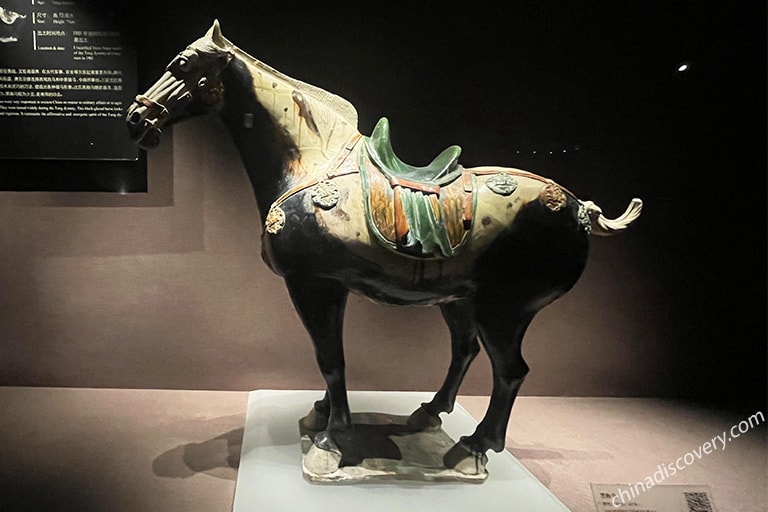 Tri-colored Black Glazed Pottery Horse (AD 618 - 907)
Tri-colored Black Glazed Pottery Horse (AD 618 - 907)
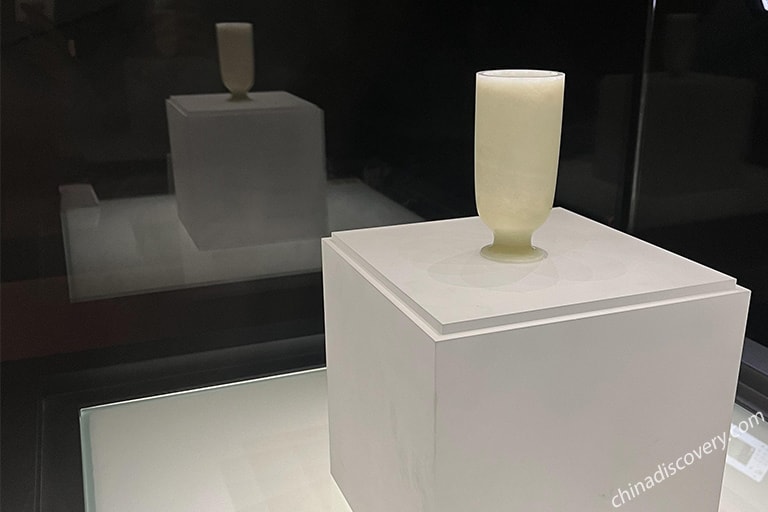 White Jade Cup (AD 220-265)
White Jade Cup (AD 220-265)
Tri-coloured Glazed Pottery of the Tang Dynasty 唐三彩馆 - Second Floor
Tri-colored glazed pottery of the Tang Dynasty (AD 618 - 907) is a treasure of ancient Chinese ceramic firing technology. Tri-color represents 3 main colors: yellow, green and white. Other colors include brown, blue, black, etc. With kaolin as raw material, Luoyang Tang tri-colored pottery has beautiful shape and gorgeous glaze color, representing the peak of China's colorful glazed pottery.
Collections here are mainly used as funerary objects, has a complete set including the civil servants figurines, heavenly king figurines, lady figurines, maid figurines, Hu people figurines, animal figurines, daily utensils, etc. They represent the colorful and prosperous social life of Luoyang, and reflect a high spirited, enterprising, open and diversified prosperous Tang Dynasty.
Representative Relics
Tri-colored Blue Glazed Horse with White Spots 三彩蓝釉白斑马: 32.5cm in height. Blue glaze is very rare in tri-colored glazed pottery. It is made by cobalt, which is rare in the Central Plains at that time and is imported through the ancient Silk Road. It not only shows the outstanding skill of the craftsman, but also is the representative of the prosperity of the Tang Dynasty.
Tri-colored Glazed Pottery Camel 唐三彩载丝骆驼: 88cm in height, 76cm in length. This strong and tall camel is a masterpiece of the tri-colored camels of the Tang Dynasty. The camel is marching with its head held high and carrying a bag of silk. Camel is the main transportation means along the ancient Silk Road.
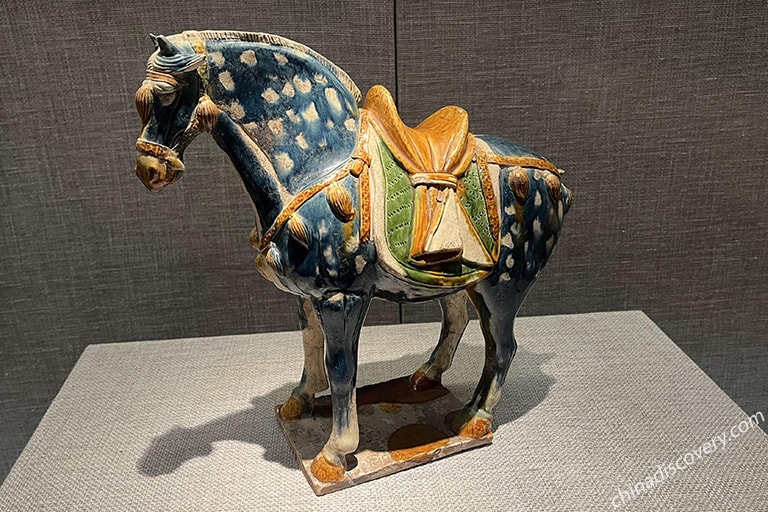 Tri-colored Blue Glazed Horse with White Spots (AD 618 - 907)
Tri-colored Blue Glazed Horse with White Spots (AD 618 - 907)
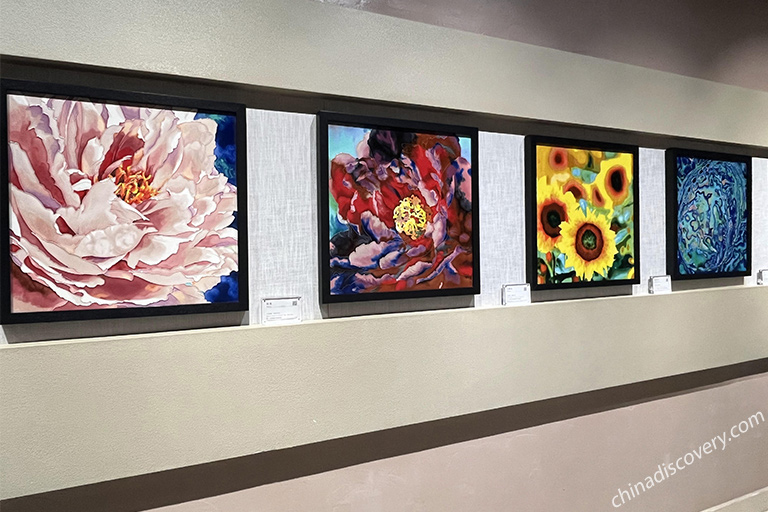 Tri-colored Paintings
Tri-colored Paintings
Carved Stone 石刻馆 - First Floor
Luoyang has a large number of stone sculptures and inscriptions in the past dynasties, spanning from the Han Dynasty (202 BC - AD 220) to the Qing Dynasty (AD 1636 - 1912). It shows distinctive local characteristics and occupies an important position in the history of ancient Chinese stone carving art. Most of the statues are carved with blue stone, white marble and sandstone, which highlight the main features of characters and animals. Some of them are exaggerated in appearance, rich and elegant in shape. Though in different styles, the items are in harmonious proportion with lively spirit and charm. The exhibition is divided into two parts: stone sculpture and tablet epitaph.
Representative Relics
Stone Bixie 石辟邪 - Treasure of Luoyang Museum: Eastern Han Dynasty (AD 25 - 220). Bixie means evil dispeller. It is a kind of Chinese mythological animal that keeps evil at bay. This stone Bixie is 1.9m high, 2.9m long and about 8 tons, carved by a whole bluestone. Its magnificence and beauty have attracted much attention and it is the most exquisite among its kind. What else makes it so special is that it has wings, which has never been found in other stone animals before.
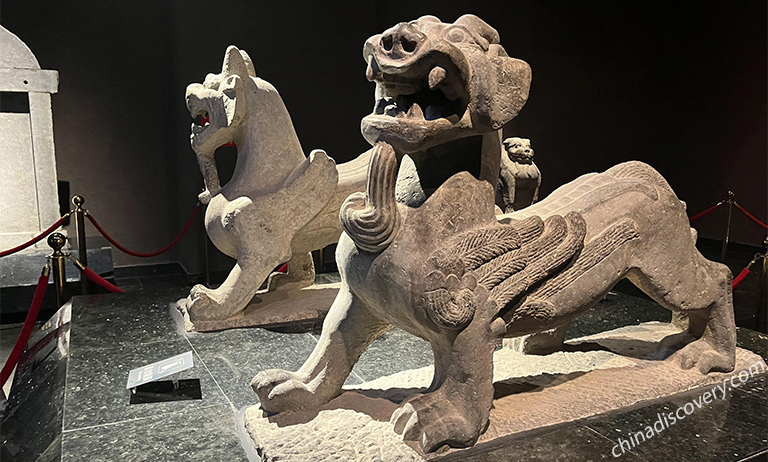 Stone Bixie (AD 25 - 220)
Stone Bixie (AD 25 - 220)
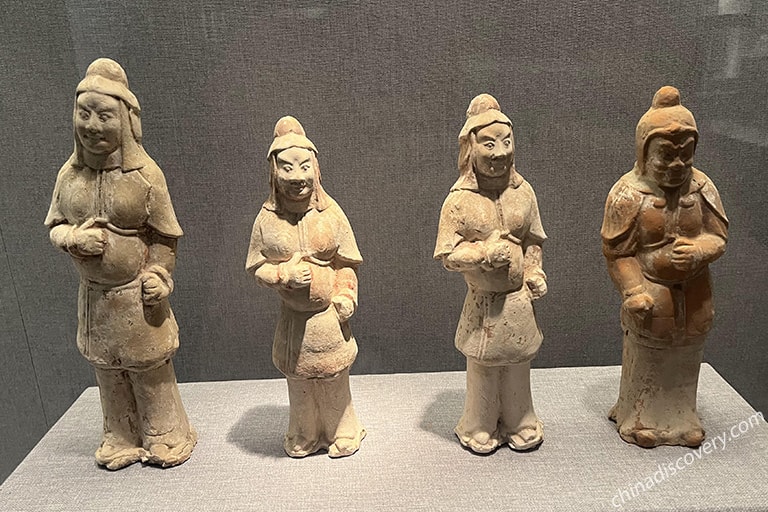 Stone Sculptures
Stone Sculptures
Pottery Figurine of Han and Tang Dynasties 汉唐陶俑馆 - Second Floor
The pottery figurines were used as funerary objects in ancient times in order to make the dead live the same life in the underworld as before. It is derived from the custom of human sacrifice that began at the end of primitive society. During the Spring and Autumn period and the Warring States period (770 BC - 221 BC), this cruel sacrifice tradition was condemned by public and banned by law. However, the concept of "treating death like living" is deep-rooted. People try their best to seek substitutes, which are, tomb figurines.
The more than 400 pieces of Luoyang pottery figurines in Han (202 BC - AD 220) and Tang (AD 618 - 907) dynasties show the simplicity of Han figurines, the rigidness of Jin figurines, the elegance of the Northern Wei Dynasty figurines, and the resplendence of Tang figurines. They not only outline the development of ancient Chinese sculpture art, but also provide us with indispensable precious entity materials.
Representative Relics
Painted Pottery of Dancing Horse and Horse Trainer 彩绘陶驯马俑与舞马: Tang Dynasty. It is the unity of strength and aesthetics to vividly show the confrontation between the horse and the horse trainer in the process of horse training.
Painted Pottery of Horses Carrying Musicians 彩绘陶骑马乐俑: Tang Dynasty. 29-33cm in height. It is a set of 10 pottery figurines, each of which is in different posture. Their horses all look gentle, like they are losing themselves in the music. It appropriately reappears the scene of musicians playing music on horse back in the Tang Dynasty.
Painted Pottery Bottle with Three Handstand Acrobats 彩绘三人倒立杂技俑陶樽: Eastern Han Dynasty. It shows the scene of three people doing handstand performance which truly reproduces the superb skills of acrobatics at that time.
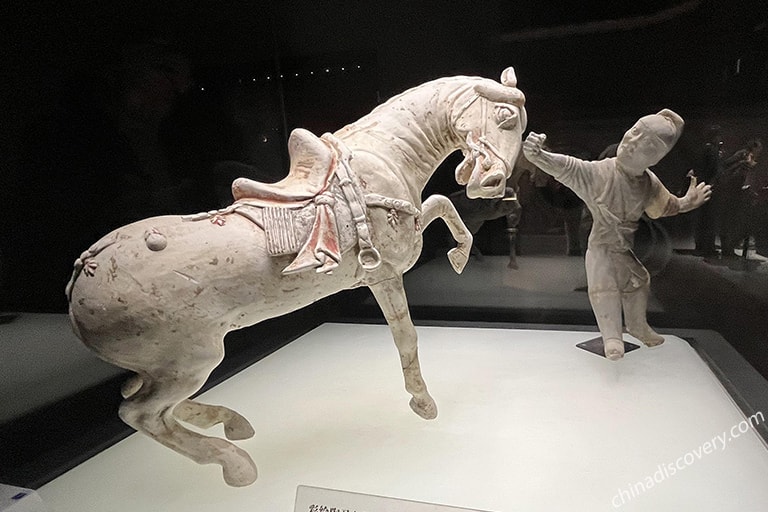 Painted Pottery of Dancing Horse and Horse Trainer (AD 618 - 907)
Painted Pottery of Dancing Horse and Horse Trainer (AD 618 - 907)
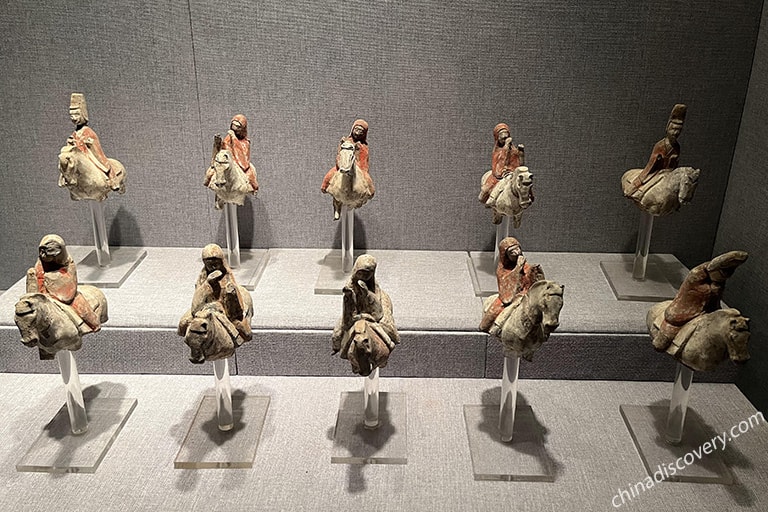 Painted Pottery of Horses Carrying Musicians (AD 618 - 907)
Painted Pottery of Horses Carrying Musicians (AD 618 - 907)
Cultural Relic of Ancient Chinese Palace 宫廷文物馆 - Second Floor
The cultural relics in this hall were originally collected in the Forbidden City in Beijing, most of which were tributes from all over the country in the Qing Dynasty. They were transferred to Luoyang Museum in 1973 under the instruction of Premier Zhou Enlai.
The collection mainly includes palace Buddhist artifacts such as Buddha statues and niches, ritual utensils, offering utensils and Buddha worship utensils. There are also many palace decorative screens, furniture, calligraphy and paintings, porcelain, etc. They are all made by precious materials (gold, silver, jade, colored glaze…) and exquisite workmanship, which are of high artistic value and are the best among the palace Buddhism and living utensils.
Representative Relics
Jinsi Nanmu Pagoda 金丝楠木塔 - Treasure of Luoyang Museum: Qing Dynasty (AD 1636 - 1912). Jinsi Nanmu is a kind of very precious wood in China and is exclusive to the royal family in the Qing Dynasty. This three-storey eight-side pagoda is dark brown, all carved from the precious Jinsi Nanmu, about 6 meters high and weighs about 4 tons. There are 304 niches around the pagoda, each of which is dedicated to a gilded Bodhisattva. The whole pagoda adopts a variety of carving techniques. With the traditional Chinese mortise and tenon technology, no nail is used here. It is a true treasure of Buddhist art and wood carving.
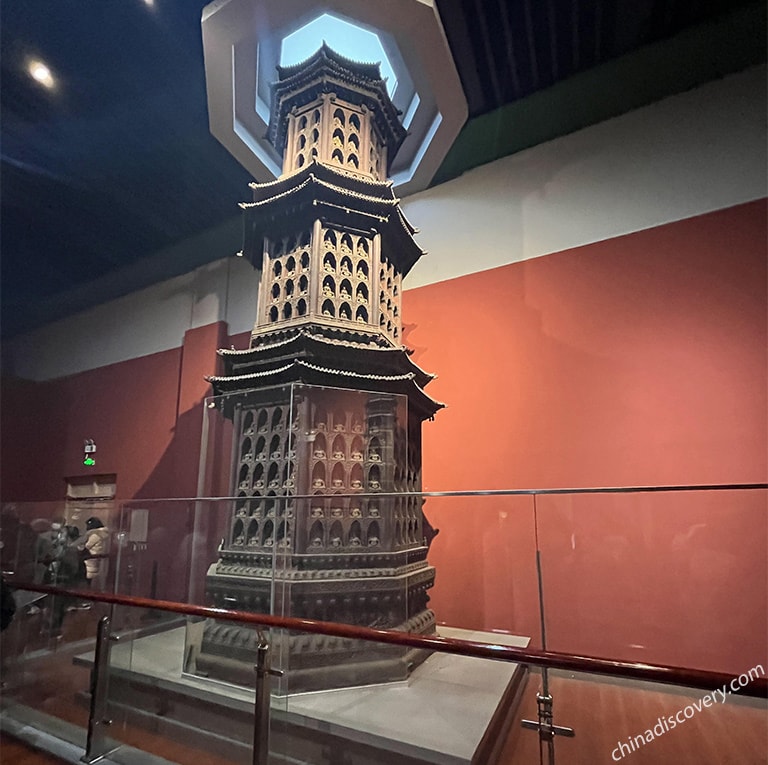 Jinsi Nanmu Pagoda (AD 1636 - 1912)
Jinsi Nanmu Pagoda (AD 1636 - 1912)
Calligraphy and Paintings 书画馆 - Second Floor
Chinese painting and calligraphy art has a long history. It has unique aesthetic value and is an artistic manifestation of the moral sentiment of the calligraphers/painters that has been cultivated for a long time.
The collection of paintings and calligraphy in Luoyang Museum is mainly from the Song Dynasty (AD 960-1279), Ming Dynasty (AD 1368-1644), Qing Dynasty (AD 1636-1912) and modern China, including works of Su Shi in the Song Dynasty, Zhang Hong in the Ming Dynaststy, Wang Duo, Zhao Zhiqian, Zha Shibiao, Kang Youwei, He Shaoji, etc. in the Qing Dynasty, and Qi Baishi, Yu Youren, Guo Moruo in modern times. Their distinctive artistic style and humanistic spirit have a profound impact on the development of Chinese painting art.
How to Get to Luoyang Museum
Luoyang Museum is located in Nietai Road, Luolong District, Luoyang City.
- 6 km away from Luoyang downtown, about 15 minutes' drive;
- 7 km away from Luoyang Longmen Railway Station, about 20 minutes' drive;
- 15.5 km away from Luoyang Beijiao Airport, about 35 minutes' drive;
- 10 km away from Longmen Grottoes, about 30 minutes' drive;
- 55 km away from Shaolin Temple, about 1.5 hours' drive.
How to Get to Luoyang: Many tourists choose to get to Luoyang first and then travel to Luoyang Museum. Luoyang can be reached by a few international flights, some domestic flights and many high speed trains. If you are already in China, it is easy to take direct flights to Luoyang from Beijing (2h), Shanghai (2-2.5h), Chengdu (2h), Chongqing (1.5h), Guangzhou (2.5h), Shenzhen (2.5h), etc., and high speed trains from Beijing (4-4.5h), Xian (1.5-2h), Zhengzhou (40 min), Shanghai (5 ~ 9h), etc. All flights land on Luoyang Beijiao International Airport and all high speed trains arrive at Luoyang Longmen Railway Stations.
Luoyang to Luoyang Museum:Luoyang is not equipped with metro at present. The most chosen way for independent travelers to get to Luoyang Museum is by taxi or bus, both of which are easy to find in Luoyang. As the bus schedule changes sometimes, you can check the specific bus route when you get to Luoyang.
It is strongly recommended to travel with China Discovery. Our local travel guide and driver will pick you up at the airport or train station as you arrive with an air-conditioned and non-smoking vehicle, and then escort you to your hotel or every attraction listed in your itinerary. Great freedom will be given to you when you need to stop for sightseeing and photograph if possible. You are sure to enjoy a comfortable, safe and efficient experience.
Luoyang Museum Travel Tips
- Ticket: The entrance fee is free for Luoyang Museum, but valid identification such as passport is needed when you collect ticket at the ticket office.
- Reservation: On ordinary days, there is no need to make a reservation. But during this COVID-19 pandemic period, Luoyang Museum receives 5000 people a day only and you need to make a reservation through the official account of Luoyang Museum on WeChat.
- Where to see the collections: Sometimes the displaying location of the items will change. If you can not find them, please consult the staff at the museum.
- Museum guide service: Luoyang Museum provides 4 rounds of free guide service at 9:30, 10:30, 14:30 and 15:30 and more on holidays and festivals. You can also rent an audio guide with a price of CNY 20 for 3 hours and a returnable deposit of CNY 300.
- Luggage storage: Luoyang Museum provides free luggage storage for the visitors. You can put your small backpacks in the lockers and consult the tourist center for large luggage.
How to Plan Your Travel in Luoyang
Usually, it takes 2 ~ 3 days to have a Luoyang tour. The highlights of Luoyang include Longmen Grottoes which is known as the finest examples of Chinese Buddhist art, 1900-year-old White Horse Temple (also China's first Buddhist temple), 2000-year-old burial site - Tianzi Jialiu Museum and beautiful Luoyang Museum with a lot of history to tell. Of course, you can't miss a Kung Fu exploration in Shaolin Temple (in Dengfeng city) if you visit Luoyang. It is only 55 km (about 1.5 hours' drive) away from Luoyang City.
☛ 2 Days Luoyang Longmen Grottoes Tour
☛ 3 Days Luoyang Kung Fu Tour
It's strongly recommended to extend your Luoyang tour to its attractive neighbors. After Shaolin Temple visit, you can spend 1 day exploring Zhengzhou or Kaifeng. If you are fond of nature, Mount Yuntai, Guoliang Village and Xiaolangdi Reservoir on Yellow River are recommended.
However, the best way to extend your Luoyang trip is starting a Xian Tour. Owning world-class treasures, Xian offers a lot to see and do. Taking a 1.5~2 hours high speed train, you can unveil an incredible experience of two old capital cities. It is quite popular to travel Beijing and Xian with Luoyang, because Luoyang is just located between them. Get inspired from our Xian Luoyang Tours now!
☛ 6 Days Ancient Xian & Henan Tour (Xian / Luoyang / Dengfeng / Zhengzhou)
☛ 8 Days China Ancient Capitals Tour (Beijing / Luoyang / Xian)
☛ 10 Days China Culture Tour Plus Shaolin Kung Fu Experience (Beijing / Xian / Luoyang / Dengfeng / Zhengzhou / Shanghai)
 Our Customers visited Luoyang Longmen Grottoes
Our Customers visited Luoyang Longmen Grottoes
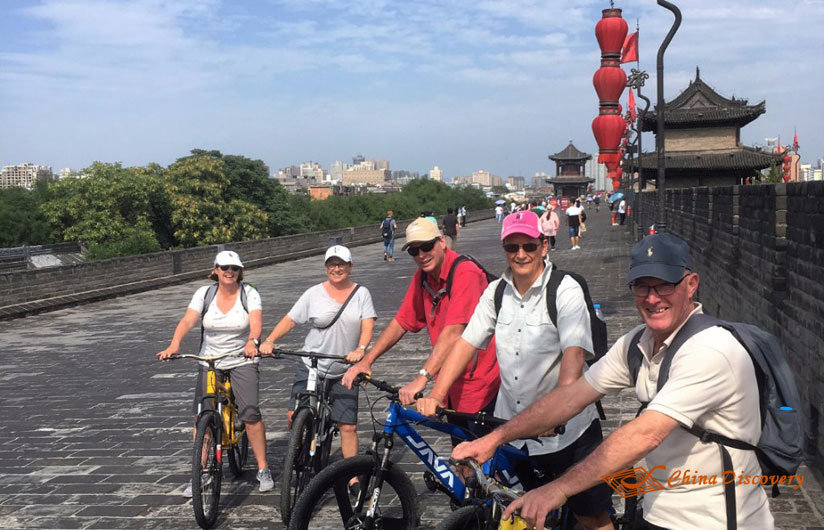 Our Customers visited Xian Ancient City Wall
Our Customers visited Xian Ancient City Wall
Get Inspired by Real Travel Stories of Our Customers
Luoyang and nearby Shaolin Temple are very popular with our customers. Since 2012, we have helped thousands of customers visited the region successfully. With our fully-inclusive private tour packages, all of our customers enjoyed their trips to magnificent Longmen Grottoes, legendary Shaolin Temple, educational Luoyang Museum, beautiful Yuntain Mountain, etc. Some of them even had the rare opportunities to take part in the grand International Peony Festival in Luoyang. Many customers suggest visit Luoyang with Beijing, Xian, Pingyao and Shandong in northern China to explore authentic Chinese culture. Below are some inspiring travel stories:
★ Cultural Immersion Trip in Ancient Capitals of China (Beijing - Taiyuan - Pingyao - Xian - Luoyang - Dengfeng - Zhengzhou - Kaifeng - Qufu - Mount Tai - Beijing)
★ Sweet Couple's 21-Day Northern China Exploration (Beijing - Datong - Mount Wutai - Pingyao - Xian - Luoyang - Jinan - Taian - Qufu - Beijing - Chengde - Beijing)
★ 19 China Trips of Vijay’s People - Spreading around Family & Friends of Wonder’s Good Service (Beijing / Luoyang / Xian / Chengdu/ Guangzhou / Guilin)
★ Sucking Cultural Fragrance from Time-honored Architectures (Kathmandu - Kunming - Lhasa - Shigatse - Xian - Luoyang - Pingyao - Datong)
Read more China travel stories > or find recommended similar tours>.
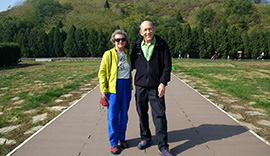
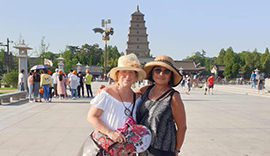 Our Delighted Customers
Our Delighted Customers
Top Luoyang Tour Packages
Helpful Luoyang Travel Guide
- Longmen Grottoes
- White Horse Temple
- Luoyang Peony Festival
- Top Attractions in Luoyang
- Things to Do in Luoyang
- Family-friendly Activities Luoyang
- Luoyang Transportation
- Luoyang Maps
- Where to Stay in Luoyang
- Luoyang Weather & Best Time
- How to Plan a Luoyang Tour
- All Luoyang Travel Guide
Helpful Henan Travel Guide
Recommended Luoyang Tours
Top 3 Luoyang tours chosen by most customers to explore Luoyang in the best way. Check the detailed itinerary, or tailor your own trip now with us.

3 Days Essence of Luoyang Tour
Luoyang / Dengfeng / Zhengzhou

2 Days Luoyang Longmen Grottoes Tour
Luoyang / Dengfeng / Luoyang

8 Days China Ancient Capitals Tour
Beijing / Luoyang / Xian
Start planning your tailor-made holiday to China by contacting one of our specialists. Once inquired, you’ll get a response within 0.5~23.5 hours.
Customize a TripHave a question? Get answers from our travel experts or guests
- Your Question:
- Your Name:
- Your Email:
- Submit

























